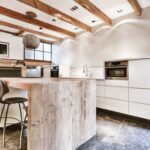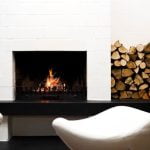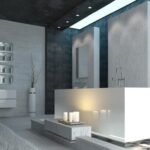In the 1970s, interior decorative pillars were a common design feature in many homes. But what do they call interior decorative pillars in 70s homes? This article will explore the various styles, materials, purposes, and impact of these iconic architectural elements.
During the 1970s, interior decorative pillars became synonymous with home design, adding a touch of grandeur and sophistication to residential spaces. Their popularity was not limited to a specific region or type of home but rather transcended different architectural styles and geographical locations.
These decorative pillars came in a variety of styles, each with its own unique aesthetic and charm. From traditional Doric columns to fluted Ionic designs, homeowners had plenty of options to choose from when it came to incorporating these structural elements into their living spaces. The use of different materials such as wood, marble, and even faux finishes further added to the versatility of interior decorative pillars in 1970s homes.
Different Styles of Interior Decorative Pillars in 1970s Homes
The 1970s was a decade known for its unique and sometimes over-the-top interior design trends, and decorative pillars were no exception. In 1970s homes, decorative pillars were a popular way to add a touch of elegance and grandeur to the interior space. These pillars came in various styles, each adding its own distinct character to the home.
One of the most prevalent styles of interior decorative pillars in 1970s homes was the Greek or Roman-inspired design. These pillars featured ornate details such as fluting, capitals, and intricate bases, emulating the classical architecture of ancient Greece and Rome. Another popular style was the geometric or abstract pillar, which showcased angular shapes and bold patterns that reflected the modernist influence of the era.
In addition to these styles, some 1970s homes also incorporated eclectic decorative pillar designs that combined elements from various architectural traditions. These hybrid styles often featured a mix of ornamental details, combining classical motifs with contemporary flair. The diversity of pillar styles in 1970s homes allowed homeowners to express their personal taste and create visually striking interiors that reflected the eclectic spirit of the era.
| Styles | Description |
|---|---|
| Greek or Roman-inspired | Ornate details such as fluting, capitals, and intricate bases |
| Geometric or abstract | Showcased angular shapes and bold patterns |
| Eclectic hybrid | Combined elements from various architectural traditions |
Materials Used for Interior Decorative Pillars in 1970s Homes
In the 1970s, interior decorative pillars were a popular design element in many homes, adding a touch of sophistication and style to the interior architecture. These pillars were commonly used to define spaces within open floor plans, as well as to support the ceiling or upper levels of the home. During this decade, there were several materials that were commonly used for creating these decorative pillars.
1. Wood: Many interior decorative pillars in 1970s homes were constructed using wood. Different types of wood, such as oak, cherry, or mahogany, were used to create a classic and elegant look. The wood was often stained or painted to complement the overall color scheme of the home.
2. Plaster: Another popular material for interior decorative pillars in 1970s homes was plaster. Plaster pillars provided a more ornate and sculptural look, often featuring intricate designs and details that added visual interest to the space.
3. Stone: In some cases, stone was also used to create interior decorative pillars in 1970s homes. Whether it was natural stone like marble or granite, or synthetic stone veneers, this material added a sense of grandeur and luxury to the home’s interior.
These materials not only added architectural interest but also contributed to the overall aesthetic and atmosphere of the home during this era. Today, many homeowners appreciate these vintage elements and seek ways to preserve or restore them as part of their home’s history and character.
The Purpose and Function of Interior Decorative Pillars in 1970s Homes
Structurally, interior decorative pillars in 1970s homes served as support for the ceiling and upper levels of the house. They were often made from materials such as wood, stone, or brick, providing stability to the structure. In some cases, these pillars also concealed load-bearing beams or columns, offering both functionality and visual appeal to the overall design of the home.
Moreover, interior decorative pillars in 1970s homes also acted as a design element that reflected the architectural trends of that era. It was common to see elaborate carvings or ornate designs on these pillars, showcasing craftsmanship and attention to detail. Overall, these pillars were an essential part of the home’s interior design during this time period, serving both practical and aesthetic purposes.
| Purpose | Function |
|---|---|
| Aesthetic enhancement | Division of living spaces |
| Structural support | Concealment of load-bearing elements |
| Architectural trend reflection | Design element showcasing craftsmanship |
How Interior Decorative Pillars in 1970s Homes Have Evolved Over Time
The 1970s saw a surge in the use of interior decorative pillars in home design. These pillars were not just structural elements, but also served aesthetic purposes, adding a touch of grandeur and sophistication to homes. Over time, the evolution of interior decorative pillars has resulted in changes in style, materials, and functionality.
Design Evolution
In the 1970s, interior decorative pillars were often characterized by bold, geometric shapes and sleek surfaces. However, as time passed, the design of these pillars underwent a significant transformation. The 1980s saw a shift towards more ornate and detailed styles, with intricate carvings and embellishments becoming popular. In the 21st century, there has been a resurgence of interest in minimalist and streamlined designs, leading to a renewed appreciation for the clean lines and simplicity of 1970s pillar styles.
Material Trends
While the 1970s saw an extensive use of materials such as marble, stone, and wood for interior decorative pillars, subsequent decades brought about a diversification in material choices. The 1980s introduced synthetic materials like fiberglass and PVC for pillar construction, offering more flexibility in design and cost-effectiveness. In modern times, sustainable and eco-friendly materials such as bamboo and recycled wood have gained popularity for their environmental benefits.
Functional Adaptations
Initially serving primarily as ornamental features or to delineate different areas within a space, interior decorative pillars have evolved to have more functional roles over time. With advancements in architectural technology, pillars are now integrated with smart home features such as concealed lighting or built-in storage compartments. This evolution reflects the changing needs and lifestyle demands of homeowners in different eras.
Maintaining and Restoring Interior Decorative Pillars in 1970s Homes
Regular Maintenance
To preserve the beauty and functionality of interior decorative pillars in 1970s homes, regular maintenance is essential. This includes dusting and cleaning the pillars to prevent buildup of dirt and grime. Additionally, inspecting the pillars for any signs of damage such as cracks or discoloration is important. By addressing these issues early on, homeowners can prevent further deterioration and maintain the integrity of the pillars.
Restoration Process
Over time, interior decorative pillars in 1970s homes may require restoration to bring them back to their original glory. The restoration process typically involves identifying any structural issues, repairing cracks or damages, and refinishing the pillars to match the original design. In some cases, homeowners may choose to update the style or material of the pillars while still staying true to the overall aesthetic of the home.
Hiring Professionals
While some homeowners may attempt DIY maintenance and restoration, hiring professionals with experience in handling interior decorative pillars is often recommended. These experts have the knowledge and skills to assess the condition of the pillars, recommend appropriate restoration techniques, and execute the necessary repairs with precision. By entrusting this task to professionals, homeowners can ensure that their interior decorative pillars are maintained and restored properly.
The Impact of Interior Decorative Pillars on 1970s Home Resale Value
Interior decorative pillars were a popular design element in 1970s homes, and they continue to have an impact on the resale value of these properties. For homeowners looking to sell a home from this era, understanding the influence of these pillars on resale value is essential.
Here are some factors to consider regarding the impact of interior decorative pillars on the resale value of 1970s homes:
- Aesthetic Appeal: The presence of interior decorative pillars can add visual interest and architectural detail to a home, which may appeal to potential buyers who appreciate retro or vintage design elements.
- Historical Significance: Many buyers are attracted to the historical significance of 1970s homes, and interior decorative pillars contribute to the overall character and charm of these properties.
- Market Demand: In some real estate markets, there may be a specific demand for homes with original 1970s features, including interior decorative pillars. This can positively affect the resale value by increasing buyer interest and competition.
Ultimately, while some buyers may view interior decorative pillars as outdated or unnecessary, others may see them as desirable and distinctive features that enhance the overall appeal and value of a 1970s home. Understanding the impact of these pillars on resale value can help sellers make informed decisions about how to present their property to potential buyers.
Retrospective
In looking back at the interior decorative pillars in 1970s homes, it is evident that these architectural features played a significant role in the overall design and aesthetic of the era. The nostalgia for these pillars reflects a time when open floor plans and bold, statement-making interior details were popular. The enduring appeal of these pillars speaks to their timeless charm and the impact they had on home design during the 1970s.
As interior decorative pillars evolved over time, they became more synonymous with a specific style rather than simply serving as structural elements. Different styles emerged, from sleek and minimalist pillars to more ornate and decorative ones, each contributing to the unique character of 1970s homes.
The materials used also varied, with options ranging from wood to fiberglass to faux finishes that mimicked stone or marble. This diversity in styles and materials allowed for personalization and creativity in home decor during this period.
Today, there remains a demand for maintaining and restoring interior decorative pillars in 1970s homes. Homeowners are embracing the nostalgia for these iconic features by preserving or updating them to fit modern tastes.
Whether it’s through refinishing or reimagining their design, interior decorative pillars continue to add value to 1970s homes, both aesthetically and sentimentally. As such, it’s clear that these pillars have left an indelible mark on home design history and continue to be revered by those seeking a touch of retro charm in their living spaces.
Frequently Asked Questions
What Are Decorative Pillars Called?
Decorative pillars are often called columns. These columns can be purely decorative, or they can serve as structural elements in a building’s design. They come in various styles and materials, such as marble, wood, or concrete, and are often used to enhance the aesthetic appeal of a space.
What Style of House Has Pillars?
Pillars are commonly found in Greek Revival style houses. This architectural style was popular in the 19th century and is characterized by its use of decorative columns on the exterior of the home. These pillars typically support a front porch or portico, adding grandeur and elegance to the overall appearance of the house.
What Is the Difference Between a Pilaster and a Pillar?
The main difference between a pilaster and a pillar lies in their function and construction. A pillar is a freestanding vertical support structure that can bear weight and provide structural support.
On the other hand, a pilaster is a flattened column that is attached to a wall and does not have any structural function. Pilasters are purely decorative elements used to create the illusion of supporting columns without actually bearing any weight.

I’m thrilled to be your companion on this exciting journey through the world of home decor and design. With a passion for turning houses into homes and a keen eye for the finer details, I’m here to help you transform your living spaces into beautiful, functional, and meaningful havens.





